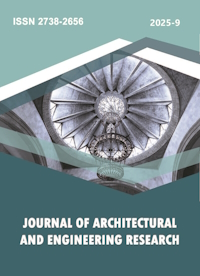Studying the Architecture Elements of Suburban Caravanserais in Central Iran to Identify Their Similarities and Differences
DOI:
https://doi.org/10.54338/27382656-2025.9-05Keywords:
architecture elements, physical typology of caravansary, commonalities and differences of caravansary, restoration and conservation of caravansary, suburban caravansary in central IranAbstract
This study explores how the architecture of Iranian caravanserais evolved due to changes in architectural knowledge, techniques, and functional needs. The main goal is to classify and compare the physical and architectural features of caravanserais in central Iran to identify their common and distinctive characteristics. The research addresses one main question: How do physical and metaphysical factors influence the formation of architectural styles?. Using a developmental and applied approach, the study combines inductive, interpretive, historical, and comparative methods. Data were collected through library research and field observations. Key architectural components—such as entrances, vestibules, porches, courtyards, rooms, porticos, stables, and towers—were analyzed in terms of spatial organization and typology. Findings show that caravanserai architecture was shaped by the construction traditions and design systems of its time, following shared frameworks created by skilled architects and coordinated institutions. By comparing architectural features, the research identifies which elements remained consistent and which evolved, offering valuable insights for the conservation and restoration of damaged caravanserais. The study focuses on roadside caravanserais in Isfahan, Qom, Markazi, and Tehran provinces, analyzing 65 examples from various historical periods in Iran’s hot and dry central regions
Downloads
References
M.Y. Kiani, V. Klais, List of Iranian caravanserais (vol. I, II). Iranian Cultural Heritage Organization, Tehran, 1994. Available at: https://surl.li/mhwlgi. Accessed on November 2 , 2025.
M.K. Pirnia, Introduction to Islamic Architecture of Iran. Science and Technology of Iran University Press, Tehran, 1999. Available at: https://library.richt.ir/site/catalogue/14366. Accessed on November 2, 2025.
M. Kavian, G. Gholami, A Study of the Evolution of the Architecture of Courtyard Caravanserais in Central Iran. Quarterly Journal of Athar, 37 (75), 49-66, 2017. Available at: http://journal.richt.ir/athar/article-717-1-fa.html. Accessed on November 2, 2025.
B. Vasigh, Z. Amini Farsani, H. Nasseri, Comparative Comparison of the Proportions Governing the Architecture of Courtyard Caravanserais in Central Iran in the Safavid and Qajar Periods. Iranian Restoration and Architecture Quarterly, 27, 65-78, 2022.
A. Moshabaki, Comparative Comparison of the Architectural Space of Safavid-Era Caravanserai with a Physical Approach. Green Architecture Quarterly, 12, 11-24, 2018.
R. Khaghani, B. Shanvaz, Caravanserais of Iran. Pazineh Publication, Tehran, 2016.
J. Neistani, M. Tatari, Study of Architectural Elements of Entrance Spaces: Case Studies of Safavid Caravanserai of Khorasan Razavi. Payam Bastanshenas (Message of the Archaeologist) Quarterly, 20-21, 2014. Available at: https://surl.li/trrqxd. Accessed on November 2, 2025.
S. Keyvanlou Shahrestanaki, H. Shadi, Rereading the Physical Characteristics of Sabzevar Caravanserai During the Safavid Period. In Proceedings of the National Conference on Sustainable Architecture and Urban Development, Iran, 2013. Available at: https://civilica.com/doc/214396. Accessed on October 18, 2025.
S.H. Pourmohammad, Studying the Cognitive Impact of Different Causes and Factors in the Formation and Organization of Iranian Caravanserai. In Proceedings of the National Conference on Humanistic Architecture and Urban Planning. Islamic Azad University of Qazvin, Qazvin, 2013. Available at: https://sid.ir/paper/894186/fa. Accessed on October 24, 2025.
M. Siroux, Iranian Caravanserai and Small Buildings Between the Roads (I. Behnam, Trans.). Publication of the National Organization for the Preservation of Antiquities of Iran, Tehran, 1949. Available at: https://surl.li/ccqoee. Accessed on November 2, 2025.
M. Siroux, Ancient Roads of Isfahan Region and their Associated Buildings (M. Mashaikhi, Trans.). Publication of the National Organization for the Preservation of Antiquities of Iran, Tehran, 1978. Available at: https://surl.li/azyvms. Accessed on November 2, 2025.
T. Khosravi Javid, S.H. Nasakhian, H.R. Jeyhani, Physical-Spatial Typology of Suburban Caravanserais on the Historical Road Network from Isfahan to Rey and Saveh Based on the Spatial Composition of the Architectural Plan. Naqsh-e Jahan (Motif of the World) Quarterly, 15 (1), 49-84, 2025. Available at: https://surl.lu/wuhfbj. Accessed on October 30, 2025.
Downloads
Published
How to Cite
Issue
Section
License
Copyright (c) 2025 Tooraj Khosravi Javid, Shahriar Nasekhian , Hamid Reza Jeyhani

This work is licensed under a Creative Commons Attribution-NonCommercial 4.0 International License.
Creative Commons Attribution-Non-Commercial (CC BY-NC). CC BY-NC allows users to copy and distribute the article, provided this is not done for commercial purposes. The users may adapt – remix, transform, and build upon the material giving appropriate credit, providing a link to the license. The full details of the license are available at https://creativecommons.org/licenses/by-nc/4.0/.













